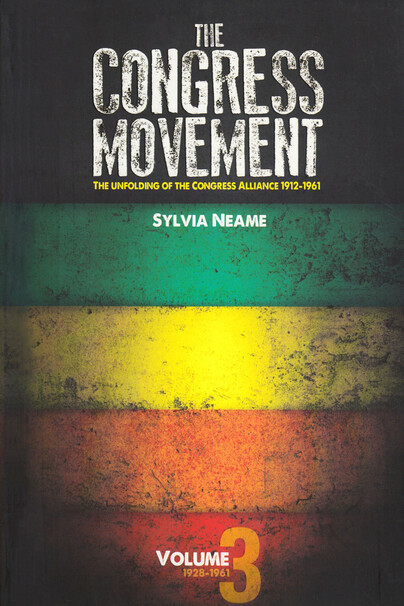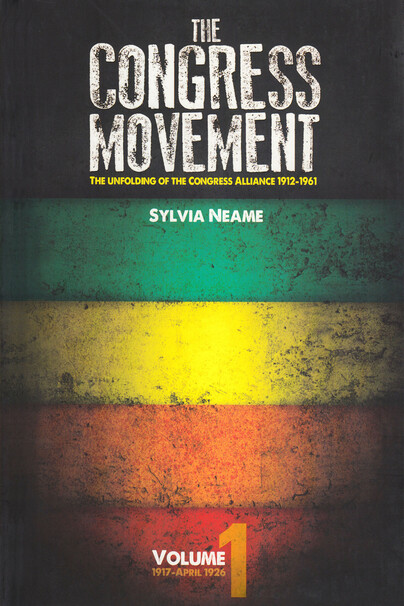

Pages: 538
ISBN: 9780796924889
Pub Date: March 2015
Imprint: HSRC Press
Price:
£28.00
Usually available in 6-8 weeks
Pages: 595
ISBN: 9780796924865
Pub Date: March 2015
Imprint: HSRC Press
Price:
£28.00
Usually available in 6-8 weeks
Description:
The Congress Movement, based on primary and secondary sources including some 80 interviews dating back to the early 1960s, uniquely combines narrative and analysis. Volume 3 explores how the ANC emerges and stps into its primary role as a national liberation movement resulting from a complex process stretching from the 1920s to the beginning of the 1960s. A key theme in this context is the integral role of the then Congress Youth League leaders such as Nelson Mandela, Walter Sisulu, and Oliver Tambo.CONTENTS: SEARCHING FOR THE ADEQUATE FORM OF THE UNITED FRONT, 1928–34: THREATS TO THE AFRICAN NATIONAL CONGRESS'S PRIMARY ROLE. Threats to the African National Congress's Primary Role. The ANC–ICU 1928 Decision to Cooperate: With an Anti-Communist Rider: Issue of Passes, 1928–30. What Kind of Organisation Was the LAR? Mahabane Takes the Lead in Calling for an African Convention. Mahabane's Policy of a Black–White Round Table and Declaration of Rights, 1929 ANC Conference. The Communists' Attitude to Mahabane's Policies. Mahabane and Communism, 1929. Maneuvers to Dismantle the ANC’s Primary Role, 1926–30. Gumede Loses the Congress Presidency. Plans to Restructure the ANC on the Basis of Employees' Organisations: Ballinger's Role. The Non-European Conference. AFRICAN NATIONAL CONGRESS AT THE TIME OF THE SEME PRESIDENCY, 1930–37: THE ORGANISATION'S CONGRESS CHARACTER IS ENDANGERED. The Organisation's Congress Character is Endangered. Seme's Political Positions at the Time of the Founding of the Congress. The New Seme Constitution. Seme and the Upper House at the Time of the Mahabane Presidency, 1937–40. Seme, Business. Fate of the Heaton Nicholls Initiative in the Framework of the Joint Select Committee. African National Congress Leaders and the Nicholls Plan. State of the African National Congress in the First Half of the 1930s. Liberals Prime DDT Jabavu as African Leader on the Franchise Proposals. Congress Leaders Call for an All-African Convention: The Regional Conferences. The All-African Convention, 1935. Maneuvers Around the "Compromise" of 1936. Thema, Dube, and Seme and the "Compromise." Seme's Removal at the 1937 Conference: Mahabane Puts the African National Congress Back on Course. THE ALL-AFRICAN CONVENTION AND THE AFRICAN NATIONAL CONGRESS, 1937–48: A FEDERAL OR UNITARY PRINCIPLE? A Federal or Unitary Principle? Kadalie's Response to the All-African Convention. Was the All-African Convention a New Social Movement? The Communists' Attitude to the All-African Convention. Reservations About the All-African Convention and Early Moves to Revive the African National Congress. The All-African Convention Challenge is Defeated. The ANC Adopts a New Constitution in 1943. Xuma and the All-African Convention: Non-European Unity Movement, Including the "Meeting of the 12 Leaders." THE AFRICAN NATIONAL CONGRESS UNDER ZUMA, 1940-49: TO WHAT EXTENT WAS IT A BREAK WITH A PREVIOUS ERA? To What Extent Was It a Break With the Previous Era? Were Congress Councillors on the Native Representative Council Mandated by the ANC? Division of Labor Between Z.K. Matthews and Xuma: The 1943 NRC Recess Committee on Representation. A New Phase Opens With Africans' Claims. The Pass Campaign, 1943–46. The Crisis Conditions of 1946. Xuma, Congress, and Trade Unionism. Xuma's Evidence to the Native Mine Wages Commission of 1943. Prelude to the African Mine Workers' Strike. The African Mine Workers' Strike, 1946. The Communists and the Question of a Non-European Trade Union Federation. What Was Xuma's Attitude Towards the Mine Strike? Adjournment of the Native Representative Council and the Smuts Proposals. Xuma, the ANC, and the Boycott of the NRC. Xuma and Organisation. Growing Political Role of Indian Leaders. The People's Assembly of 1948: Problems of the United Front. PHASE OF THE PROGRAMME OF ACTION, 1948-50: A COMPLICATED HISTORICAL JUNCTURE. A Complicated Historical Juncture. The ANC and the General Election of 1948. Emergence of the Youth League: What Was Its Strategy? The CYL's Programme for a New South Africa. The Issue of a Programme of Action Prior to the ANC's 1948 Conference. The ANC Annual Conference, December 1948, and a Programme of Action. Efforts to Draft a Programme of Action During 1949. Response of the Communists to the Programme. The Difficulties of Leading Youth Leaguers with the Defend Free Speech Convention, 1950. Suppression of Communism Act: Mandela, Tambo, Sisulu Jettison Anti-Communism. CHAMPION, MSIMANG, AND THEMA LEAVE THE AFRICAN NATIONAL CONGRESS, 1951–1952: END OF AN ERA. End of an Era. The CYL and Radical Democracy. The CYL and Trade Unionism: The CYL’s Attitude to the ICU. Kadalie's Last Years. Champion's Efforts to Secure the Role of "Leader of Natal." Champion's Growing Irritation with the ANC. Natal, the National Fund, the Afrikaner Nationalists, and the Zulu Royal House. African–Indian Confrontation in Durban: The 1949 Riots. Champion's Attitude to the Youth Leaguers and to the Programme of Action. Msimang Turns Against Champion and Lutuli Takes Over the Natal Leadership. The Baloyi Issue, Congress, and Afrikaner Nationalists. Selope Thema's Role in Congress, 1946–49. Thema in 1949. Establishment of the National-Minded Bloc. The National-Minded Bloc, Business, and "Economic Independence." The Youth Leaguers and the National-Minded Bloc. Common Basis of Thema, Champion, and Msimang Leave the ANC. Defiance Campaign, 1952. Xuma and the ANC, Late 1940s/Early 1950s, Including His Attitude to the Defiance Campaign. Postscript: How Did Xuma Come to Turn Against the ANC? LUTULI AND MANDELA, 1952–61: THE MAHABANE HERITAGE. The Mahabane Heritage. The Problem of a United Front with the Liberal Party. The ANC, the Liberal Party, and the COP. What Influences Shaped the Freedom Charter? The Land Shall Be Shared Among Those Who Work It. What Organisation or Organisational Framework Was Responsible for the Charter? Lutuli and the Freedom Charter. The M-Plan: Preparation for Revolution? The M-Plan and the South African Congress of Trade Unions. The 1958 ANC Constitution and the Question of Centralisation. Political Orientation of the IDAMF. All-in African Conference, October 1956. Multiracial Conference, December 1957: The Question of the Broad Front. Proceedings of the Multiracial Conference. Was the Multiracial Conference Simply a Dead End? Dialogue Continues. Liberal Party–ANC Relationship in the Late 1950s. The PAC. Why Did the ANC Leadership Prevaricate on the Issue of a Pass Campaign? Growing Lack of Confidence in the Method of Mass Campaigns. Crisis Symptoms in the Economy. "Sharpeville": Was it a Herald of Revolution or Counter-Revolution? Conceptual Considerations in Relation to the Call for a National Convention, 1960–61. Consultative Conference, December 1960, and All-in African Conference, March 1961.
The Congress Movement, based on primary and secondary sources including some 80 interviews dating back to the early 1960s, uniquely combines narrative and analysis. Volume 1 traces the unfolding of the congress movement from its beginnings early in the 20th Century and looks at socialist and other forces that played an integral part in its formation. The 1918-1920 upsurge, which included an African mineworkers' strike, played a key role in this development and laid the basis in the 1920s for a partnership between the ICU and ANC.CONTENTS: TOWARDS A TYPOLOGY OF THE ANC AND THE ICU: A CRITICAL ASSESSMENT OF A RANGE OF VIEWS.The CI's "Black Republic" Resolution.The ICU as a Rural Movement—Helen Bradford.Erosion of the Historical Method, 1970s–80s: Neo-Marxists and "Social Historians."Characterizing the ANC in Terms Of a Relationship to State Power—Susan Booysen and Paul Rich.The ANC, Popular Struggle, and Marginal Groupings—Philip Bonner.The Discontinuous Nature of ANC History—Tom Lodge.A National-Political History of the ANC—Peter Walshe.The ANC and Labour–Continuity in Congress History—Peter Limb.Origins of the ANC—André Odendaal.THE WORKERS' UPSURGE OF 1918-20: BIRTH OF THE CONGRESS MASS MOVEMENT.The ISL and the Establishment of the IWA.Development of the IWA Prior to the Upsurge.Tensions Within the IWA.Wages Movement of 1918.The Moffat Report.Pass Campaign of 1919.The 1920 Strike.National Congress and the Formation of a National Workers' Organisation, 1920.Response of the Ruling Class.Mahabane Comes to the Fore.CLEMENTS KADALIE AND SELBY MSIMANG, 1919-1921: CONGRESS, THE ICWU, AND THE ICU.Kadalie's Background.Early Days of the ICU.Cape Town Strike, 1919.Selby Msimang's Background.SANNC Conference of May 2910: African Worker Organisation and Meshach Pelem.Establishment of the ICWU at Bloemfontein, July 1920.Problems of Structure Arising From the Bloemfontein Conference.The ICU Claims the Role of a Nationwide Movement.The Port Elizabeth Events of 1920: Masabalala and Msimang.Kadalie and Masabalala Break with Msimang at the Time of the July 1921 ICWU Conference.Msimang Drifts Into the Camp of the Joint Councils.THE 1922 STRIKE AND UPRISING: WAS IT ANTI-BLACK?State of the Parliamentary Parties Preceding the Strike.The 1922 Strike.Different Streams in the Strike.Role of Afrikaner Nationalist Politicians.Role of the Blacks in the Strike.The Cape, the ICU, and the 1922 Strike.BLACK ORGANISATIONS IN TRANSITION, 1921-EARLY 1924: RELATIONS WITH THE PARLIAMENTARY PARTIES.The ICU's October 1921 Conference.The ICU's 1923 Conference.The Contradictions Continue: ICU and ICWU.A New Phase: Growing Disillusionment of Black Leaders with Smuts.Annual Conference of Congress, May 1923.The ICU in the New Phase.The CP's Attitude Towards the ICU and Black Nationalism into Early 1924.The ICU's January 1924 Conference.THE 1924 GENERAL ELECTION: WHITE-BLACK FRONT AGAINST SMUTS?Pact Policies for the General Election.The Pact and the Mining Industry.The Communists and the 1924 Election.Cape Black Leaders Attempt to Establish a United Front for the General Election.The All-African Convention, May 1924.Mahabane and Segregation: Run-up to the Election.ANC Annual Conference, May 1924, and the General Election.Cape Blacks in the Election Campaign.Election Results: How Did the Blacks Vote?Contradictory Nature of Hertzog's Segregation Policy in its Early Phase, Including in His Smithfield Address.THE ICU AND ANC, MID-1924 TO APRIL 1926: NON-COOPERATION AND EFFORTS TO ESTABLISH A UNITED FRONT.The ICU Comes to the Rand.ICU–ANC Relations in the Setting of the ANC's 1925 Conference.Selope Thelma's Difficulties with Congress, Mid-1923 to 1925.The ICU's 1925 Conference.CU–ANC and the Pass Issue in 1925.IU–ANC: Organisational-Structural Aspects.ICU–ANC: The Social Aspect.Receding of Garveyist Influence in the ICU: Role of Thaele.Kadalie's Internationalist Outlook.CP–ICU, 1924–Early 1926.Growing Disillusionment with Hertzog.Mahabane Calls for a National Convention.ANC in Special Convention, January 1926.The Special Convention and the Question of Mass Struggle.Problem of the United Front Between the ICU and the ANC.Postscript: Kadalie Maintains the Role of the ICU as a Potential Wing of the ANC.STRUCTURAL ASPECTS OF THE ICU, 1925-APRIL 1926: TRADE UNION, AFRICAN-COLOURED ALLIANCE, OR AFRICAN NATIONALIST MOVEMENT?The ICU, The Stevedores, and the Rest of the Dockworkers.Growth of a Town-Based Branch Structure.ICU Offices, Manned by Provincial Secretaries, Tend to Undermine the Branch Structure.Opposition to Tyamzashe's Bureaucratic Methods.The Communists and the Question of the ICU'[s Realignment on a Trade Union Basis.The ICU's 1925 Constitution.A Coloured or an African Organisation?Problems of the ICU's Leading Organs.La Guma's Inspection Report.National Council Meeting and Conference, April 1926, In Relation to Structural Issues.

